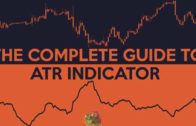ATR, or the Average True Range indicator measures the volatility of a market by measuring the price range for a defined amount of candlesticks. It is used as a measure of potential volatility and quite often used by traders to determine how far to set targets or even stop losses. While ATR is used with just about any time frame, the original use of ATR was based upon daily candlesticks, analyzing the volatility over the last 14 candlesticks, which is the default setting.
Recently, the ATR indicator has been used by day traders, as it can give traders an idea of how much further a trade can go. It also can suggest perhaps if a market is overbought or oversold, whether or not it has the ability to continue going further before perhaps closing out your positions and going home. Longer-term traders will look at the ATR to determine whether a pullback in a trend, or of bounce from oversold condition is possible.
How to read ATR in Forex and Using the ATR
Using the Average True Range indicator when trading Forex is quite common, but you should remember that the indicator is not necessarily a system in and of itself. It is simply a way to determine whether you are in a trend in environment, and whether or not there is enough left in a potential trend or move for the session to get involved. Obviously, the ATR will be greatly influenced by how quick the pair moves, so the ATR range for a minor pair or exotic pair will be much higher than something like the EUR/USD.
Keep in mind that the ATR reading will change drastically as extreme conditions occur. It should also be noted that this measures volatility, not directionality. In other words, if the ATR comes in at 220 pips on a daily chart, it does not matter whether or not the market is going up or down, it gives you the same reading. In that sense, you should look at the ATR is a secondary indicator, as it will simply tell you the potential size of the move, not which direction you should be trading. Having said that, if you have an ATR of 75 on the chart you are trading, and the recent move has only moved 20 pips, all things being equal you should be looking for a move of 55 pips.
You can also use the ATR to set stops, which is probably one of the biggest uses for the ATR on the whole. Again, if you have an ATR that is 75, a stop loss of 75 pips is quite often used as the potential stop loss. Think of it this way: if the market moves more than the average against you, then it suggests that you are completely wrong in the position, and it is time to get out.
A few things to consider
Keep in mind that the indicator itself is not reason enough to take a trade. It simply a bit of a roadmap of what could happen, not even necessarily what will happen. You need to have a system in place to take trade, using the ATR to back up your stop losses and/or targets. Because of this, you need to already know what you are doing before using this indicator as a supplement.



 Difference Between Hammer and Hanging Man 2023 [ Must Watch for Trader ]
Difference Between Hammer and Hanging Man 2023 [ Must Watch for Trader ]